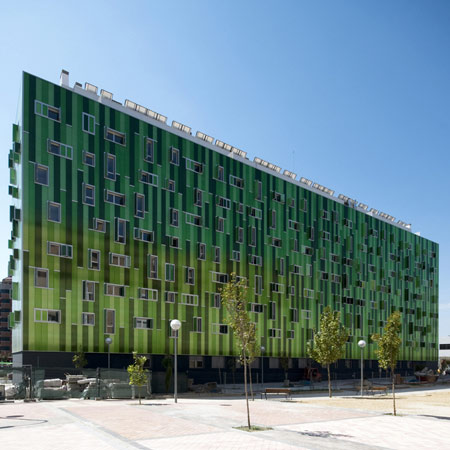
123 Social Green Housing by SOMOS Arquitectos
Madrid practice SOMOS Arquitectos have completed a social housing project in Madrid, Spain.
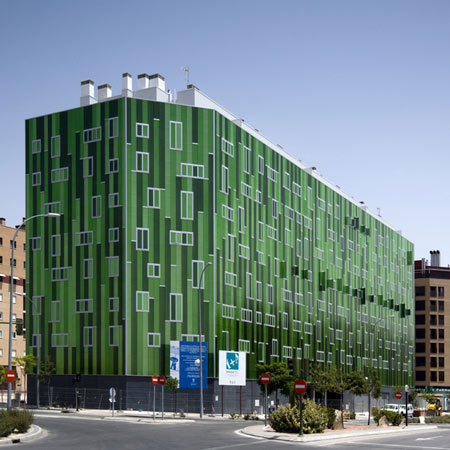
Called 123 Social Green Housing, the eight-storey building incorporates 123 apartments.
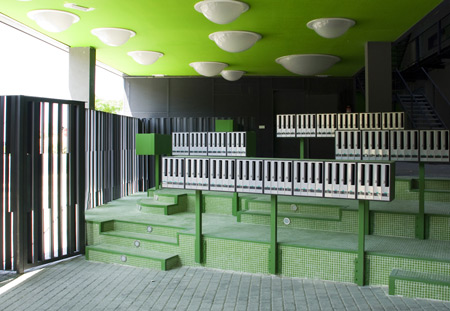
The building's exterior is clad in plastic panels on aluminium frames, in three shades of green.
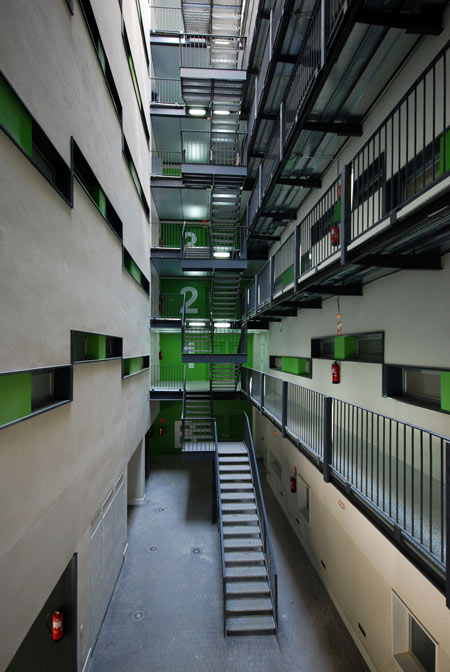
Windows are shaded by 369 shutters in six types, also made of polycarbonate and aluminium.
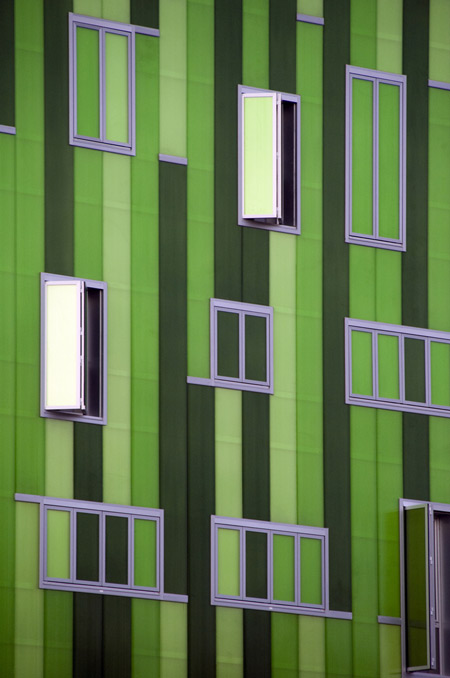
Two entrances lead to one hall with mail boxes arranged on terraces.
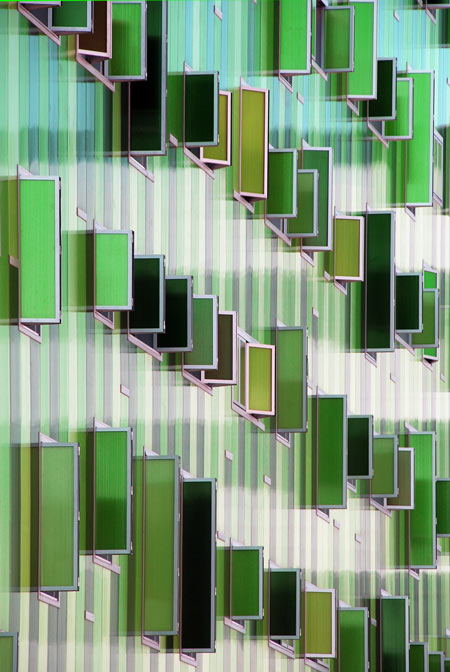
An internal courtyard with steel galleries and staircases provides access to apartments.
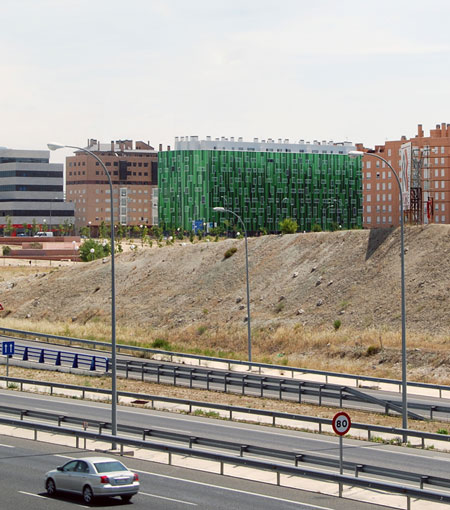
Dark grey metal surounds the ground floor with apartments elevated two metres above street level, while white penthouses crown the top of the building.
The project is part of the same development as Celosia Residence by MVRDV and Blanca Lleó (see our previous story).
Here's some more information from SOMOS Arquitectos:
--
WORK TITLE: 123 SOCIAL GREEN HOUSING IN VALLECAS (MADRID). SPAIN.
SMALL DESCRIPTION
This social housing project in Madrid has an original facade design with polycarbonate panels in three hues of green. In fact, it is one of the first residential projects which features plastic materials as a skin. The programme, including 123 social housing apartments, is called to be one of the new urban icons on the outskirts of Madrid.
1. MEMORY
The project rises eight floors above the ground along one of the limits of the block imposed by the restrained urban planning. The great scale of the building forces it to act as a visual screen for the green area that stands aside, physically protecting it. The volume, specifically fixed according to the rigid city-planning rules that prevail within the scope of the PAU de Vallecas and the optimization of the space to obtain the highest amount of apartments asked by the developer, drove us to respect the enveloped volume determined in the planning, using other tools to give a new urban approach to the intervention. Thus, the facade remains as one of the most powerful instruments to manipulate the perceptive scale.
As we will specify later, colours, sizes and displacements for the openings are regarded with attention. The ground floor is a delicate area, as it must deal with the street, separating car and pedestrian entrances. The apartments in this floor are oriented towards the so called green area and they have been raised two metres from street level in order to provide them with some extra isolation from the view of the possible passer-by. The official facade opens towards the hustle and bustle common of a commercial street with a four lane road running along. It gathers the commercial premises and the three accesses (parking in and out and pedestrian).
Even though the number of apartments demanded two separate accesses, we decided to create a single welcome space which would be big enough to interact with the scale of the building. This hall area is completely open on both sides and its rectangular shape establishes a dialogue with the free-form platforms of the mailbox area. Thus, the entrance is modulated by means of generous terrasses finished with vitreous mosaic, prepared for the installation of the mailboxes, which grow in height emphasizing the landing as a highly compressed space, where you’re almost able to touch the plastic semispheres.
These transitions of scale are unified through a green ceiling completely illuminated with the so called network of protruding lights-skylight.
The building poses reflections dealing with the scale reduction, bringing a friendly relation with the surroundings. The facade is split into small coloured units that are combined with each other and are able to transmit a changing sensation, a dynamic chameleon-like skin. The volume crystallizes through open celled polycarbonate panels fixed over aluminum profiles, creating a sustainable and recyclable skin, whose properties will be identified later in detail. These panels use the gradation of tones and brightness with a substrate of neutral color determined by the outer shell of the facade, achieving the right combination of both materials in order to make the entire facade to vibrate, entering in resonance with that light so characteristic on the city of Madrid.
Instead of the common window roll-up blind, we have designed specific shutters for the project. Three-hundred and sixty-nine openings fixed through six different types. They open outwards and fold until they rest perpendicular to the facade. They have been made in aluminium and finished with the same open celled polycarbonate panels used in the facade.
They are designed as an integral solution, pre-assembled in a factory, already arriving to the working site as a completely finished unit which comprises all necessary elements (framing, hinges, doors..) to settle it up within the facade, thus simplifying the layout on site. They have two possible positions which change the perception of the volume. Completely closed they seem to merge within a monolithic volume giving continuity to the vertical strips. Completely opened they are transformed into unequal colored fins giving the façade much more plasticity.
The ground floor is enveloped by a dark grey metal skin which gives weight to the changing green volume. The building is topped by the penthouses finished in white which seem to blur with the clear skies. In the inside, a long courtyard flanked with access galleries provides the apartments with light and crossed ventilation, helping them to become completely open to two opposed facades. The light galleries made out of steel wind through the inner void and optimize the ratio of vertical access cores on each floor. As added values, they grant hygiene and salubrity to the common space of relation.
Translucent, polycarbonate hung ceilings are settled like linen cloths that illuminate the accesses to the apartments. They also conceal the electrical wiring and provide diffused light. The slim stairs are solved extending out from these galleries in an overhang which jumps in the air connecting each floor. In order to capture as much light as possible, everything is finished is white with several touches of colour on the windows and on the elevator fronts. Floors in galvanized steel is suitable for outdoor use and helps to reflect light into the courtyard. We have considered a mixed structural solution. The main body of the building is solved in reinforced concrete, whereas the circulation system of galleries and the stairs in the courtyard are solved in steel.
2. CONSTRUCTION AND SUSTAINABLE CRITERIA.
The outer skin of the building poses an innovating solution through the extensive use of a material with high energy-saving benefits: the OPEN-CELLED POLYCARBONATE, which until now hadn’t been applied in social housing, where the cost factor of €/m2 is absolutely decisive and limited.
We are employing 40 millimeters thick open celled extruded polycarbonate panels with seven internal walls and six air chambers, protected against U.V. rays. Its modulation is 500mm wide and variable length, only limited by the transportation conditions, arriving in this particular case at 11 meters.
This celled structure helps to give the panel much more resistance to flexion. Each item is fixed side by side by means of a male-female joint, a device which allows the panels to be installed without a second vertical order of aluminium profiles, avoiding therefore the heat dispersion from the inner camera due to the thermal bridges created by the structure.
Panel color finish is chosen using the RAL color system which helps to give accurate match between panels, using three different tinted tones of green which have been specially produced for this design. The polycarbonate panel’s choice emerges as an important technical improvement which as a whole offers important advantages:
ENERGETIC EFFICIENCY: it is an extruded material, its outer face is protected from U.V. rays. Its six internal channels divided by walls form air chambers within the panel, creating another extra thermal chamber, thus increasing the insulating power of the original brick facade in a very high percentage. The male-female joint assembly allows the suppression of the vertical profiles. Due to the height of the panels, this joint is secured at specific points by aluminium clips, diminishing therefore the heat dispersion produced by thermal bridges of the skin. Also, this material contributes improving other skin qualities, for example, enhancing its sound insulation, again increasing the original values.
ECOLOGICAL: as ecological qualities we should point out his recyclebility, the low amount of energy used on manufacturing and
transportation, its high degree of purity and mixing with different raw materials, and its high degree of industralization in production and assembly. The material offers a 10 year guarantee.
EASYNESS AND ECONOMY OF POSITIONING ON WORKSITE: its great lightness, between 10 and 12 times less from the weight of glass with equal thickness, allows to optimize manpower in its assembly and run times. Its high level of prefabrication reduces costs for preparation of material.
IMPACT RESISTANCE: thanks to its structure combining six cells, it owns great impact resistance and an optimal behavior to flexion.
FACTORY FINISHING: the panels come out perfectly sealed from the factory with an opaque aluminum tape on its upper end and another micro-perforated aluminum tape on its lower end in order to allow correct ventilation, avoiding inner staining and being protected from possible fungus.